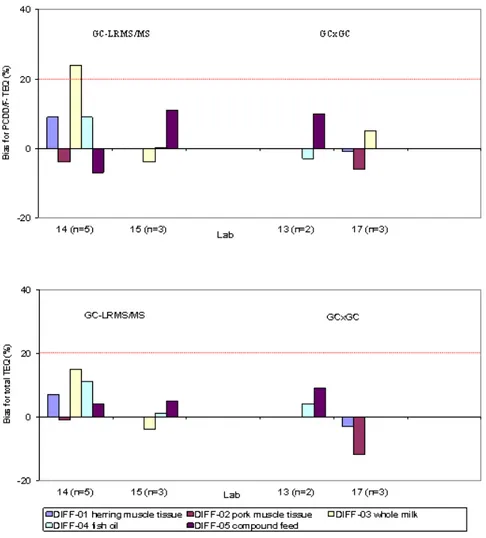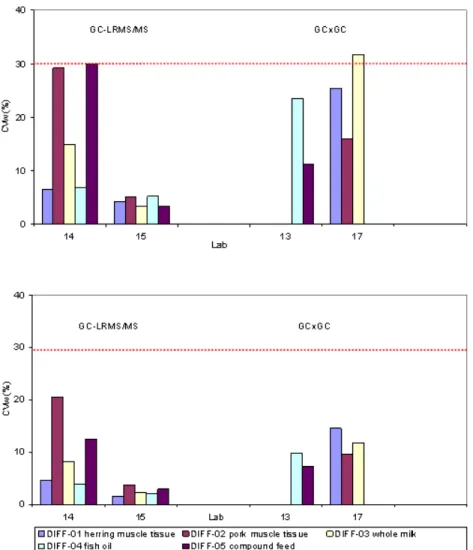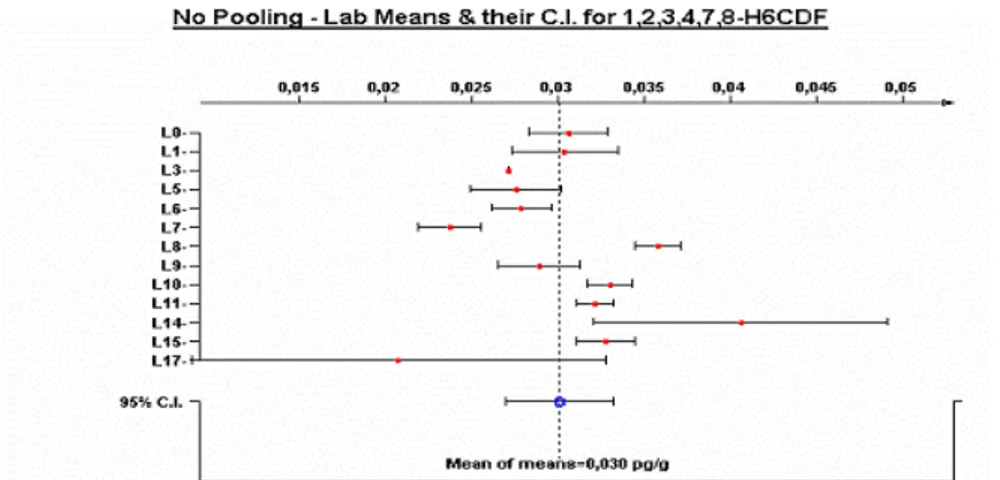C:\web sites\PDF_Test\pdf\1730.pdf
Introduction
Within the framework of the EU-DIFFERENCE project, an interlaboratory study was organized to assess the feasibility of certification of new reference materials for PCDD/F and dioxin-like PCB analysis in food and feed. In view of the Commission Directives 2002/69/EC and 2002/70/EC, consensus values and their uncertainties were based only on results obtained with the confirmatory method GC -HRMS. Because another objective of the DIFFERENCE project was the performance characterization of potentially cheaper and faster screening methods, some experienced GC-LRMS/MS and GCxGC laboratories were also invited to analyze the five test materials of the interlaboratory study. In this paper the bias and within-lab precision obtained with the various chemo-analytical methods is presented and discussed.
Materials and methods
Three food and two feed materials were selected and prepared for this study: -a wet herring tissue, naturally contaminated (DIFF-01);
-a wet pork tissue, obtained by mixing regular meat with meat from a feeding experiment (DIFF-02); -a whole milk, to which additional PCDD/Fs and dioxin-like PCBs were spiked (DIFF-03);
-a fish oil, naturally contaminated (DIFF-04);
-a compound feed for pigs, of which the lipid source was a salmon oil to which additional PCDD/Fs and dioxin-like PCBs were spiked (DIFF-05).
The materials were selected and prepared so that the levels in the final materials were close to the limits specified in the EC Directive 2001/102/EC and EC Regulation 2375/2001, except for the fish (with PCDD/F-TEQ level of about half the EC limit). The PCDD/F-TEQ and total TEQ, calculated from the GC-HRMS consensus values for the individual congeners after elimination of technically explainable outlying lab means, are given in Table 1. For the fish oil lower and upper bound TEQ were slightly different, so both are presented. The extractable fat content in Table 1 is the mean value obtained by the labs. Similarly, a moisture content in the compound feed of 9.3% was calculated.
Table 1 : Material characteristics
Details about the optimization of the screening methods as well as typical instrumental conditions have been published elsewhere1-4. The GCxGC laboratories used ECD (lab 13) or TOFMS (lab 17) detection.
As guidelines for the evaluation, the requirements for analysis of PCDD/Fs and dioxin-like PCBs laid down in the Commission Directives 2002/69/EC and 2002/70/EC were applied, i.e.:
-trueness: -20 to +20% for confirmatory (GC-HRMS) methods
-CVw: <30% for screening methods, <15% for confirmatory (GC-HRMS) methods.
The above criteria refer to the total TEQ value, but they were also used for the PCDD/F-TEQ value.
Results
The biases for the PCDD/F-TEQ and total TEQ observed with the chemical screening techniques are summarized in Figure 1.
Performance of GC-LRMS/MS and GCxGC methods for compliance monitoring of the
PCDD/F-TEQ and the total TEQ in food and feed
Rudy Van Cleuvenbergen1, F. Javier Santos2, Gauthier Eppe3, Karin Wiberg4, Peter Haglund4, Jean-François Focant3 1Vito 2 University of Barcelona 3University of Liège 4University of Umeå Material PCDD/F-TEQ (pg/g product) total TEQ (pg/g product) extractable fat (%) Herring muscle tissue (DIFF-01) 1.89 3.76 17.6 Pork muscle tissue (DIFF-02) 0.307 0.446 23.6 Whole milk (DIFF-03) 0.0945 0.220 3.68 Fish oil (DIFF-04) 5.46-5.56 11.0-11.2 -Compound feed (DIFF-05) 0.463 1.23 6.79
ANA - General – Analytical
388
Figure 1: Biases for PCDD/F-TEQ (upper) and total TEQ (lower) with GC-LRMS/MS and GCxGC methods.
It can be concluded that both GC-LRMS/MS and GCxGC (with ECD or TOFMS detection) can yield very good PCDD/F-TEQ and total TEQ estimates at the concentration levels investigated. With one exception all biases complied with the trueness criteria for a confirmatory method in the Commission Directives 2002/69/EC and 2002/70/EC, as did the biases of the HRMS datasets used to calculate the congener consensus values. The GC-LRMS/MS data from lab 15 for fish and pork tissue were not retained because of an extraction problem identified at the stage of the technical evaluation.
Figure 2 shows the within-lab precision observed for the chemical screening techniques.
ANA - General – Analytical
389
Figure 2: Within-lab precision for PCDD/F-TEQ (upper) and total TEQ (lower) with GC-LRMS/MS and GCxGC methods.
Only in one case the limit set for screening methods was slightly exceeded. The GC-LRMS/MS technique appeared able to achieve a similar precision as GC-HRMS, though the performance may strongly depend on the working conditions of the lab. On an overall basis, no clear relation between the within-lab precision and the matrix analyzed was found. It should be noted that the CVw values obtained in this feasibility study most likely do not represent within-lab reproducibility conditions completely.
Though the chemo-analytical methods investigated in this study can provide sufficiently accurate TEQ estimates, most of them may yield rather variable results for the mass fractions of individual congeners compared to the GC-HRMS confirmatory method, as illustrated in Figure 3. This is probably related to a higher limit of quantification and/or a more difficult peak integration. One of the GC-LRMS/MS labs (lab 15) reached a similar precision as the GC-HRMS labs in this feasibility study, but this required special precautions for instrument maintenance (e.g. frequent cleaning of the ion volume), which may not be sustainable in routine practice.
ANA - General – Analytical
390
Figure 3: Determination of 1,2,3,4,7,8-H6CDF in whole milk DIFF-03; L14 and L15 applied GC-LRMS/MS, L17 applied GCxGC-TOF
Acknowledgements
The DIFFERENCE project was financially supported by the European Community (contract G6RD-CT-2001-00623). The analytical contribution of the participating GC-HRMS laboratories is gratefully acknowledged.
References
1.Santos F.J., Malavia J., Ábalos M., Abad M., Rivera J. and Galceran M.T. (2004) Organohalogen Compounds 66: 238-243.
2.Eppe G., Focant J.F., Pirard C. and De Pauw E. (2004) Talanta 63, 5: 1135-1146.
3.Danielsson C., Wiberg K., Korytár P., Bergek S., Brinkman U.A.Th. and Haglund P. (2005) J. Chromatogr. A : in press.
4.Focant J.F., Eppe G., Scippo M.L., Massart A.C., Pirard C., Maghuin-Rogister G. and De Pauw E. (2005) J.
Chromatogr. A : in press.


